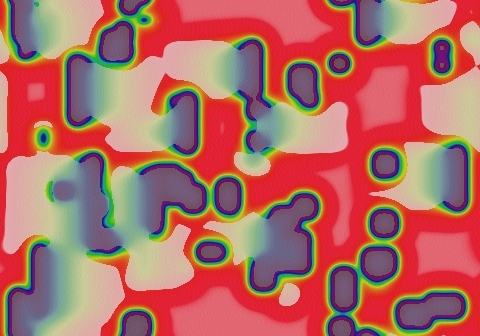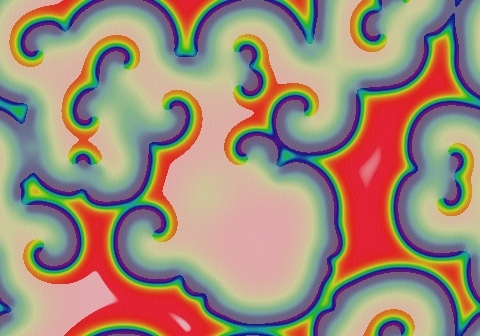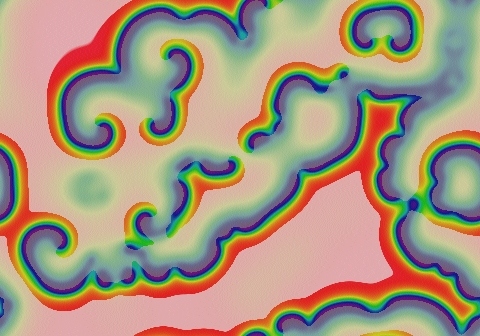Gray-Scott Model at F 0.0100, k 0.0450
These images and movie demonstrate the behavior of the Gray-Scott reaction-diffusion system with σ=Du/Dv=2 and parameters F=0.0100, k=0.0450.
These parameters support continuous spiral patterns, similar to those in the B-Z (Belousov-Zhabotinsky) reaction. Wavefronts develop many irregularities, helping to create new spiral seeds and preventing any one spiral from getting much bigger than the examples seen here. (Compare to the smoother wavefronts, and larger spirals, seen to the immediate west.)
This pattern continued with the same appearance seen here for over 420,000 tu, then quickly changed to a single wave front traveling to the right.
This simulation was performed with the same starting pattern as that to the immediate west; note the initial similarity, and substantial differences after about the first 500 tu.
Categories: Pearson β; Wolfram 3 (glossary of terms)
 increase F increase F
 | |||
 decrease k  |


|
15 frames/sec.; each fr. is 22 iter. steps = 11 tu; 1801 fr. total (19,811 tu) |  increase k 
|

|


| ||
 decrease F decrease F
 |
In these images:
- Color indicates level of u, ranging from purple (lowest u values) through blue, aqua, green, yellow and pink/red (highest u values)
- Areas where u is increasing are lightened to a light pastel tone; where u is decreasing the color is vivid.
- In areas where u is changing by less than ±3×10-6 per tu, an intermediate pastel color is seen. This includes areas that are in steady state or equilibrium.
''tu'' is the dimensionless unit of time, and ''lu'' the dimensionless unit of length, implicit in the equations that define the reaction-diffusion model. The grids for these simulations use Δx=1/143 lu and Δt=1/2 tu; the system is 3.2 lu wide. The simulation meets itself at the edges (periodic boundary condition); all images tile seamlessly if used as wallpaper.
Go back to Gray-Scott pattern index
This page was written in the "embarrassingly readable" markup language RHTF, and was last updated on 2015 Nov 07.
 s.27
s.27